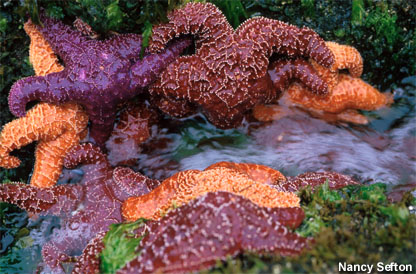
Source of Image
Notes for Chapter 23:
Echinoderms
Click link to return to Lecture
Schedule
or back to Chapter 20
or ahead to Chapter 25
Chapter 23 Assignment: 458-471; 476-478; RQ-23: 1-4, 6-7, 11
Introduction: A Design to Puzzle the Zoologist
Featured Animal: Pisaster
ochraceus (ochre seastar)
More Links: 1
- 2
- 3 - 4
- 5
- 6
- 7
Click link to return to Lecture
Schedule
or back to Chapter 20
or ahead to Chapter 25 (not yet available)
The following outline of lecture notes does not follow Ch. 23 headings
I. Echinoderms:
Key terms: pentamerous symmetry, ambulacra, water-vascular system, tube feet, pedicellaria, papulae, ampullae, madreporite, ossicles, stereom, pyloric ceca, pluteus larva, bipinnaria larva, brachiolaria larva, hydrocoel, trimeric paired coeloms (a deuterostome feature)
symmetry: think 5 except in larvae/fossils
skeleton: endo/collagen
water vascular system: uniquely echinoderm
nerves: no brain, a diffuse nervous net
respiration: extensions of coelom
fat storage: pyloric ceca
larvae: pluteus vs. bipinnaria
II. Introduction to Deuterostomes
Current classification of bilaterian animals:
Bilateria
Protostomia
Lophotrochozoa (flatworms, molluscs, annelids)
Ecdysozoa (arthropods, nematodes)
Deuterostomia (echinoderms, hemichordates, chordates)
Deuterostome features (see p. 459):
• blastopore (usually) becomes the anus, never becomes
the mouth
• coelom forms through enterocoely (budded off archenteron
- p. 163)
• three pairs of coelomic pouches in larva
(as in hemichordate larvae - p. 484)
• endomesoderm (mesoderm from gut through enterocoely)
• skeleton from mesoderm (not from ectoderm as in protostomes)
• radial cleavage
• regulative (indeterminate) cleavage
(4-cell stage cells still
form "normal" larva - see Fig. 8-14, p. 168)
III. Classification of Echinoderms (living
groups only - see p. 476)
Echinodermata
Crinoidea (sea lilies and feather stars)
Eleutherozoa (mouth
faces down)
Asteroidea (sea
stars)
Concentricycloidea
(sea daisies)
Ophiuroidea (brittle
stars)
Echinoidea (sea
urchins)
Holothuroidea (sea
cucumbers)
IV. Diversity:
About 6,000 living species
About 20,000 fossil species
"Stereom" ossicles – characteristic crystalline
structure/composition
(high-magnesium)
Paleontologists can easily identify fossils as echinoderm
ossicles
Early Echinoderms did not have radial symmetry
It is uncertain whether they had a water vascular system
"carpoids" sometimes considered "calcichordates"
not echinoderms
(i.e., more closely related to chordates)
V. Echinoderm Feeding:
Seastars
many are predators
stomach can come out of body
Urchins
scrapers, drift kelp, etc.
5
teeth form "Aristotle’s
Lantern"
Brittlestars
many catch food with tube feet
others are omnivores (eat anything)
5 jaws
all lack an anus (secondary loss)
Sea cucumbers
suspension, deposit, or detritus feeders
use tentacles - modified tube feet
can spew guts - eviscerate
Crinoids
arms with pinnules
tube feet on each pinnule catch food
Other features:
pedicellariae
– defense or surface cleaning (only in seastars and urchins)
regeneration - widespread
VII. Echinoderm Features (more detailed)
symmetry
larvae are bilateral
adults are pentamerous (but see cladogram!)
The primitive condition
was not pentamerous (p. 477)
1st deuterostomes
were bilateral
1st echinoderms
were bilateral or trimerous
Living echinoderms
all descendants of a pentamerous ancestor
skeleton
endoskeleton of calcareous "stereom"
ossicles
bound together with flexible/stiff collagen
water
vascular system (Figs. 23-3, 23-19)
left hydrocoel in larva (Fig. 23-9)
madreporite
(like a master cylinder in car brake system)
stone/ring/radial/lateral canals
tube feet - ampulla/sucker
ambulacrum
nervous
nerve net (epidermal nerve plexus)
seastars have eyespots
at tips of arms
respiration
papula
(skin gills of seastars), hemal system (?)
fat storage
pyloric ceca of seastars (stores energy
for gonads)
larva (Fig. 23-10) - similar to hemichordate
larva
they start as a gastrula
larva, then develop to
a bipinnaria larva (so far, as in
hemichordates)
(Look ahead, next chapter, Fig.
24-4, p. 484)
later, the type of larva differs,
depending on the group
urchins and brittlestars: pluteus
larva
(termed echinopluteus
or ophiopluteus)
seastars: bipinnaria
larva –> brachiolaria
larva
Click link to return to Lecture
Schedule
or back to Chapter 20
or ahead to Chapter 25
This page created 10/26/01 © D.J. Eernisse, Last Modified 10/29/01, Links Last Completely Checked 10/29/01